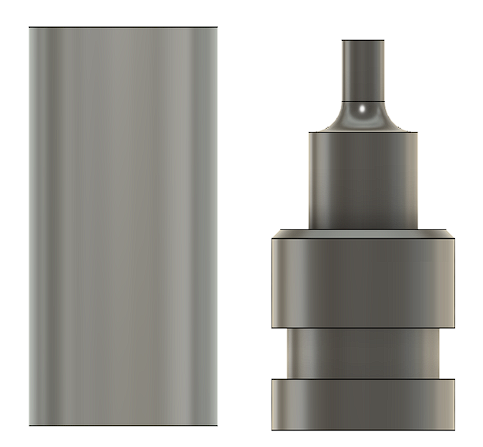CNC turning – facing
In this learning path we will learn about facing operation in CNC turning
First step in CNC machining is analysing desired final product and determining proper order of neccesary steps and operations which must be taken to achieve desired result. By looking at this picture try to make a list of operations needed to get to desired shape of final product.

Read the text explaining the process of facing for CNC turning.
Face roughing in CNC turning is a machining operation aimed at removing excess material from the face of a workpiece to prepare it for subsequent machining operations or to achieve the desired final dimensions. Here’s a breakdown of the process:
- Workpiece Setup: Similar to profile roughing, the process begins with securing the workpiece firmly in the chuck of the CNC lathe. The workpiece is positioned such that the face to be machined is accessible to the cutting tool.
- Tool Selection: A cutting tool suitable for face roughing is chosen. This tool is typically a carbide insert or solid carbide tool designed to efficiently remove material from the face of the workpiece.
- Tool Path Programming: The CNC programmer creates a toolpath using CAM (Computer-Aided Manufacturing) software. The toolpath defines the path that the cutting tool will follow as it removes material from the face of the workpiece. In face roughing, the toolpath is typically programmed to move across the face of the workpiece in a series of passes, gradually removing material to the desired depth.
- Setting Cutting Parameters: The CNC operator sets cutting parameters such as cutting speed, feed rate, and depth of cut based on the material of the workpiece, tooling, and desired surface finish. In roughing operations, higher cutting speeds and feed rates are often used to maximize material removal rates.
- Execution: The CNC machine is programmed with the toolpath and cutting parameters. The machine then automatically moves the cutting tool across the face of the workpiece, removing material in layers or passes until the desired depth is achieved. The cutting tool may traverse back and forth across the face of the workpiece, removing material in a systematic manner.
- Chip Evacuation: As material is removed, chips are generated. Cutting fluid or coolant may be used to lubricate the cutting process and aid in chip removal.
- Monitoring and Inspection: Operators may monitor the operation to ensure that everything is running smoothly. Periodic inspections of the workpiece may also be conducted to verify dimensional accuracy and surface finish.
Analyse the video and answer following questions:
1. Have you noticed any errors in facing operation? What are they?
2. Has the operation achieved shape of final product?
3. What other operations are requirde to finalise product?
4. What changes would you suggest to improve facing operation?
Resource information